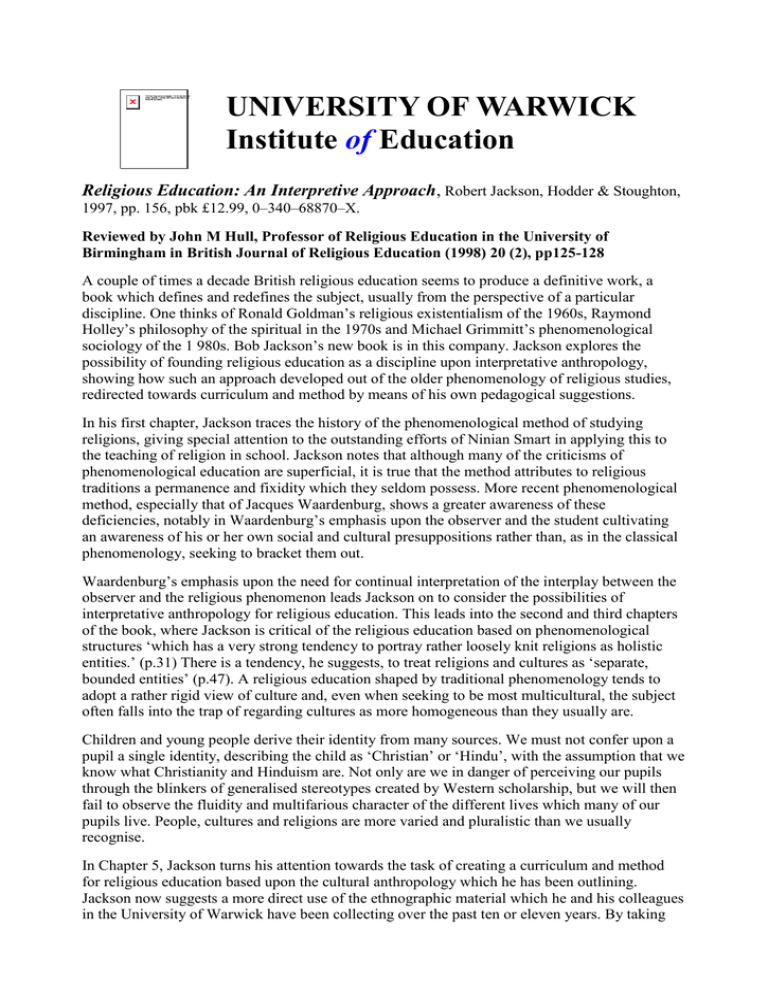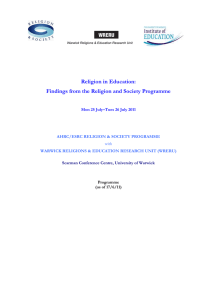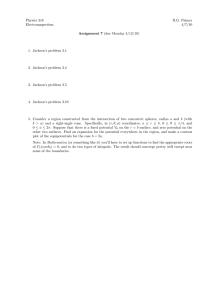UNIVERSITY OF WARWICK Institute Education of
advertisement

UNIVERSITY OF WARWICK Institute of Education Religious Education: An Interpretive Approach, Robert Jackson, Hodder & Stoughton, 1997, pp. 156, pbk £12.99, 0–340–68870–X. Reviewed by John M Hull, Professor of Religious Education in the University of Birmingham in British Journal of Religious Education (1998) 20 (2), pp125-128 A couple of times a decade British religious education seems to produce a definitive work, a book which defines and redefines the subject, usually from the perspective of a particular discipline. One thinks of Ronald Goldman’s religious existentialism of the 1960s, Raymond Holley’s philosophy of the spiritual in the 1970s and Michael Grimmitt’s phenomenological sociology of the 1 980s. Bob Jackson’s new book is in this company. Jackson explores the possibility of founding religious education as a discipline upon interpretative anthropology, showing how such an approach developed out of the older phenomenology of religious studies, redirected towards curriculum and method by means of his own pedagogical suggestions. In his first chapter, Jackson traces the history of the phenomenological method of studying religions, giving special attention to the outstanding efforts of Ninian Smart in applying this to the teaching of religion in school. Jackson notes that although many of the criticisms of phenomenological education are superficial, it is true that the method attributes to religious traditions a permanence and fixidity which they seldom possess. More recent phenomenological method, especially that of Jacques Waardenburg, shows a greater awareness of these deficiencies, notably in Waardenburg’s emphasis upon the observer and the student cultivating an awareness of his or her own social and cultural presuppositions rather than, as in the classical phenomenology, seeking to bracket them out. Waardenburg’s emphasis upon the need for continual interpretation of the interplay between the observer and the religious phenomenon leads Jackson on to consider the possibilities of interpretative anthropology for religious education. This leads into the second and third chapters of the book, where Jackson is critical of the religious education based on phenomenological structures ‘which has a very strong tendency to portray rather loosely knit religions as holistic entities.’ (p.31) There is a tendency, he suggests, to treat religions and cultures as ‘separate, bounded entities’ (p.47). A religious education shaped by traditional phenomenology tends to adopt a rather rigid view of culture and, even when seeking to be most multicultural, the subject often falls into the trap of regarding cultures as more homogeneous than they usually are. Children and young people derive their identity from many sources. We must not confer upon a pupil a single identity, describing the child as ‘Christian’ or ‘Hindu’, with the assumption that we know what Christianity and Hinduism are. Not only are we in danger of perceiving our pupils through the blinkers of generalised stereotypes created by Western scholarship, but we will then fail to observe the fluidity and multifarious character of the different lives which many of our pupils live. People, cultures and religions are more varied and pluralistic than we usually recognise. In Chapter 5, Jackson turns his attention towards the task of creating a curriculum and method for religious education based upon the cultural anthropology which he has been outlining. Jackson now suggests a more direct use of the ethnographic material which he and his colleagues in the University of Warwick have been collecting over the past ten or eleven years. By taking living themes from the lives of the actual children they have studied, rather than imposing upon the children the abstract categories of phenomenological classification, Jackson hopes to realise a religious education which will be both scientific and yet person centred. There is much sensitive work in distinguishing the language of the religious outsider from that used by the religious insider. There are analogies between the experience of children on the outside and inside, and these analogies form the themes of educational investigation. In this way, school children will be helped to have a vivid and realistic understanding of the religious people and cultures around them. As children and adults become aware of the similarities by analogy between their own lives and interests and those of the other people they are studying, they will be thrown into a sharper awareness of their own situation. It is at this point that the religious education intended to deepen our understanding of religion starts to produce a religious education intended to contribute to the spiritual and moral development of the pupil. Jackson now introduces the concept of edification. This is both similar to yet different from Michael Grim mitt’s famous idea about ‘learning from religion’. The implications of this both for the curriculum and for child development are outlined for each key stage. Hopefully, children and young people will be edified as they realise and re-examine their own presuppositions and commitments in the light of those of other people. Naturally, there can be no guarantee that this edification will actually take place, but Jackson believes that the open and conversational approach to religious education which flows from his ethnographic methods will at least put children in the way of these transforming experiences. In the final chapter, Jackson discusses some limits and criticisms of the approach. Here we have an interesting and important discussion about the character of religious claims to truthfulness and the conflicts between religious people which these different claims can generate. Jackson frankly admits that his method is not ideally suited to consider religious doctrine as truth, but he believes that this should certainly take place in religious education. His own approach is not intended to be a comprehensive method for religious education, but one contribution to the repertoire of the teacher and student of religious life. Moreover, such discussions about truth are best when they bubble up spontaneously in the classroom in response to children’s questions. It might be objected that the Warwick approach minimises religious traditions by reducing them to minute particulars and ignoring the comprehensive integrity of the traditions as entireties. In reply, Jackson points out that he is not opposed to treating religions as whole entities, provided that it is recognised that there are many interpretations of this wholeness, and the wholes themselves are continually evolving and relating. Without such qualifications, religious education will, in Jackson’s view, remain stuck in the misleading study of ‘world religions’. Jackson’s ethnography is similar to the Birmingham ‘gift to the child’ approach in that it studies particular elements or tiny samples of religious life rather than dealing with religious traditions in their entirety, but whereas the samples in the Warwick work are chosen in accordance with ethnographic research and are related to the actual lives of children and communities, the materials chosen in the Birmingham work are selected right from the beginning with an educational purpose in mind. While the Warwick approach puts the religious material vividly into its concrete local context, the Birmingham approach deliberately takes the religious material right from the start on educational grounds. This is why the Birmingham material must be inserted back into its context, and the third stage of the Birmingham pedagogy is thus called ‘contextualisation’. The Warwick material, on the other hand, is in its context right from the beginning. Thus the criteria for content selection are rather different. The Warwick approach selects material because it has already bubbled up in the lives of children as recorded by the researchers. The Birmingham ‘bit of religious stuff’ or ‘numen’ is chosen because of its potential to arouse the interests of children, that is to convey gifts to them. Another interesting point of contrast is that while both Birmingham and Warwick emphasise the human development of the pupil as being the desirable end result of religious education, they differ in the way this is to be stimulated. Edification, in the Warwick approach, is more spontaneous, and based upon analogies between the lives of children. The Birmingham ‘reflection’ stage of the lesson encourages children to respond to the religious material in a way which has already been structured (although not predetermined) by the contrast between the ‘entering device’ and the ‘distancing device’. These devices, however, are always pedagogical, and do not arise out of any method used for studying religion. The Birmingham approach is an educational method, only loosely related to the character of religion itself and how to study it. The Warwick approach has the great advantage of being based clearly and firmly upon a specific method in the social sciences used for the study of religion. Warwick and Birmingham have a common interest in rejecting the politics of inter4aith competition. This is achieved through concentration upon the method itself (Birmingham) or by turning the research method into the classroom method (Warwick). Neither approach falls into the older classifications such as thematic or systematic. It would be the task of a more extensive review to assess the considerable quantity of curricular material which the Warwick approach has generated. At present, in a review devoted only to Bob Jackson’s new book, it is sufficient to conclude where we began. Religious Education: An Interpretive Approach is a major contribution to the academic and professional study of religious education. It is well written, packed with interesting information and important observations, builds an important new bridge between religious education and the social sciences, and holds out the promise of further exciting developments. It must be regarded as essential reading for all those having a serious concern with the character and the quality of British religious education. [WRERU Homepage] These pages are maintained by u.mckenna@warwick.ac.uk.




